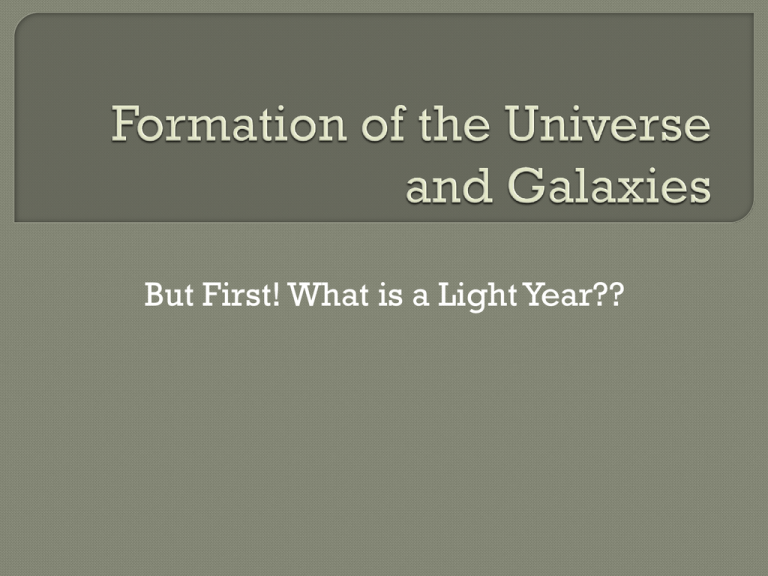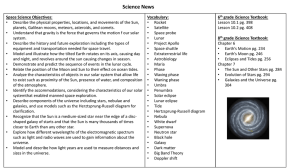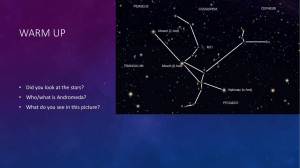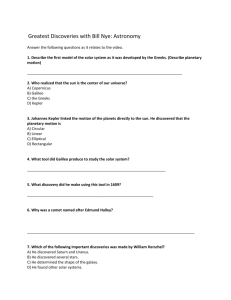But First! What is a Light Year??
advertisement

But First! What is a Light Year?? A light year is a way of measuring distance. That doesn't make much sense because "light year" contains the word "year," which is normally a unit of time. Even so, light years measure distance. Light travels at 186,000 miles per second (300,000 kilometers per second). Therefore, a light second is 186,000 miles (300,000 kilometers). A light year is the distance that light can travel in a year, or: 186,000 miles/second * 60 seconds/minute * 60 minutes/hour * 24 hours/day * 365 days/year = 5,865,696,000,000 miles/year OR…… 1 LIGHT YEAR • • The universe began with a hot explosion called the Big Bang. The aftermath of the Big Bang consisted mostly of radiation, but as things cooled, the elements hydrogen and helium formed. http://imgsrc.hubblesite.org/hu/e xplore_astronomy/skywatch/db/3 07/audio/SkyWatch_30711252010.mp3 • Big Bang Theory - Evidence for the Theory • First of all, we are reasonably certain that the universe had a beginning. • Second, galaxies appear to be moving away from us at speeds proportional to their distance. This is called "Hubble's Law.” This observation supports the expansion of the universe and suggests that the universe was once compacted. • Third, if the universe was initially very, very hot as the Big Bang suggests, we should be able to find some remnant of this heat. In 1965, this was discovered a 2.725 degree Kelvin (-454.765 degree Fahrenheit, -270.425 degree Celsius) Cosmic Microwave Background radiation (CMB) which pervades the observable universe. • Finally, the abundance of the "light elements" Hydrogen and Helium found in the observable universe are thought to support the Big Bang model of origins. A cloud in space Made of gas and dust • Can have stars inside Most of the ones we see are inside our Milky Way Galaxy Different types Orion image at Basis of modern theory of planet formation. Planets form at the same time from the same cloud as the star. Planet formation sites observed today as dust disks of T Tauri stars. Sun and our solar system formed ~ 5 billion years ago. a), (b) The solar nebula contracts and flattens into a spinning disk. The large blob in the center will become the Sun. Smaller blobs in the outer regions may become jovian planets. (c) Dust grains act as condensation nuclei, forming clumps of matter that collide, stick together, and grow into moon-sized planetesimals. (d) Strong winds from the stillforming Sun expel the nebular gas. (e) Planetesimals continue to collide and grow. (f) Over the course of a hundred million years or so, planetesimals form a few large planets that travel in roughly circular orbits. The Big Bang Theory considers the creation of all the matter and energy that exists in the universe.. Anywhere.. The Solar Nebula theory uses that matter and energy, to create galaxies and solar systems. A large group of stars outside of our own Milky Way Made of billions to trillions of stars • Also may have gas and dust Spiral, or Image at elliptical, or irregular shaped NOAO/AURA/NSF Images at Images at http://hubblesite.org/newscenter/archive/releases/galaxy/elliptical/2007/08/image/ NASA and NOAO/AURA/NSF Images at http://hubblesite.org/newscenter/archive/releases/galaxy/irregular/2005/09/res has about 200 billion stars, and lots of gas and dust is a barred-spiral (we think) about 100,000 light-years wide our Sun is halfway to the edge, revolving at half a million miles per hour around the center of the Galaxy takes our Solar System about 200 million years to revolve once around our galaxy Image at



